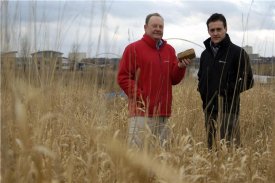Feb 16 2010
A five-year research project has come up with a way of generating green energy from a humble everyday grass.
 Dr Richard Lord, Reader in Environmental Geochemistry and Sustainability, (left) with Richard Green, BioReGen Project Officer, both at Teesside University, Middlesbrough, pictured on the banks of the River Tees.
Dr Richard Lord, Reader in Environmental Geochemistry and Sustainability, (left) with Richard Green, BioReGen Project Officer, both at Teesside University, Middlesbrough, pictured on the banks of the River Tees.
Researchers at Teesside University’s Contaminated Land and Water Centre began the project in 2004 to see which plants could best be grown on brownfield sites as a way of improving unsightly blots on the landscape.
Now, the research by the BioReGen (Biomass, Remediation, re-Generation) project team has revealed that reed canary grass can be turned into an excellent fuel for biomass power stations and, on a smaller scale, boilers in buildings like schools.
The native British grass is turned into bricks and pellets. These not only burn well but also don’t add to greenhouse gases or contribute to global warming.
The team experimented with four types of plant, willow trees, the current favourite for biomass power stations, and the miscanthus, reed canary and switch grasses.
Tests were carried out on sites around the region with work supported by a 1.2m Euros grant from the European Union’s LIFE-Environment research programme.
Dr Richard Lord, Reader in Environmental Geochemistry and Sustainability, said: “We have narrowed the plants down to reed canary grass because it grows well on poor soils and contaminated industrial sites. That is significant because in areas like Teesside, and many similar ones around the country, there are a lot of marginal or brownfield sites on which reed canary grass can be grown.
“Selecting such sites means that the grass can be grown without taking away land which would otherwise be used in food production, a key concern for those involved in the biomass and biofuel sectors.”
Having reached maturity, which takes two years, reed canary grass is harvested and baled up before being turned into bricks and pellets.
Dr Lord said: “The test burnings have shown that reed canary grass produces a good, clean fuel without picking-up contamination from the soil.
“Reed canary grass has great potential because it offers a suitable use for unsightly brownfield sites while producing an excellent fuel at a time when the world is crying out for new ways of producing green energy.
“Our research also suggests that the end product is improved soil quality and biodiversity at the greened-up sites.
“We are now examining ways in which we can commercialise this idea and are already talking to a number of major biomass power station operators.”